Naturalist’s Notebook: April 11 to April 18
Before I say anything about whales, I would like to apologize to any of you who have been looking for the blog postings from the Dolphin Fleet. In the past two years, we have had two new guys expanding the Fleet’s webpage and, alas, the blogs kind of got lost in the shuffle. However, access to the blogs has been restored to both you and I so here we go. And thank you for your patience.
In reading the accounts of the whalewatches of this first long week of the 2015 season, I was reminded of something that I used to tell the passengers during my first season as a Center for Coastal Studies naturalist. I used to start my introduction by explaining that, both at the Center and on the Fleet, we took a full systems (or ecological) approach to both our whale studies and our whalewatching. What I meant by that was simply that because whales live at the top of the food chain and feed so very low in it they make excellent biological indicators. If you have healthy, growing populations of whales, you likely have healthy, thriving populations of most of the various organisms beneath them on the food chain. Grant it, that is a very simplified way to look at things, but for the purpose of whalewatching, it holds true enough. What it really means for whalewatching is that if you know what whales feed on and you know where to find it, then you know some good places to start looking for whales. In short, you use other environmental indicators as signs of whales.
Lets start with the water. In the spring, when you are looking for whales, one of the species you might encounter is the North Atlantic Right Whale. Right whales feed predominantly on small crustaceans called copepods. Right Whales are not looking for one or two copepods. They are looking for millions of copepods. When these tiny animals are present in the water in numbers like that, the water commonly takes on a pinkish hue. Sometimes the mats of copepods are thick enough that they turn the whole surface of the sea pink. Other times, they appear as pink patches or striations in the water.
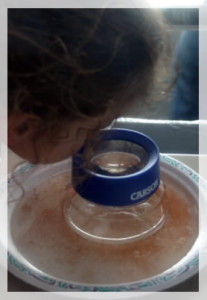
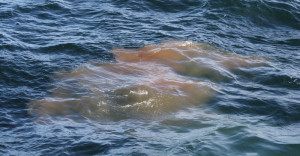
Right Whales (and Sei Whales) will feed on this zooplankton. So will Basking Sharks. In fact Basking Sharks have a remarkably similar feeding strategy as the Right Whales. The Right Whale opens its mouth and swims forward in the water, allowing the water to enter its mouth and get deflected off of the tongue before being filtered out between the whales baleen plates. The water is passively expelled while the copepods collect on the inside fringes of the baleen. Basking Sharks swim through the water with their mouths open allowing the water to pass over their gills for oxygen exchange. Along thr rigid supports of the gills, spines called gill rakers collect the zooplankton from the water as it passes around them. The water exits through the shark’s gill slits and the copepods are swallowed. So not only is the coloration of the water a possible indicator of where you might find a whale, the presence of other species, in this case sharks, might provide a clue to the presence of whales.
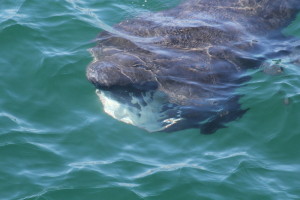
Other kinds of whales that are common here, and the Sei Whale also, feed on small, schooling fish like sand launce, herring, and mackerel. Large concentrations of any of these species near the surface might cause a shadowy look to the water as you approach and then turn to a silvery shimmer as you pass over top of them. Also, the smaller sizes of these fishes, and especially the sand launce, will feed near the surface on the same kinds of zooplankton as the Basking Sharks and Right Whales. So many times when you are on the water, the surface will kind of look like it is boiling due to the millions of small fishes darting around and grabbing even smaller animals inches below. Another environmental indicator to be watchful of.
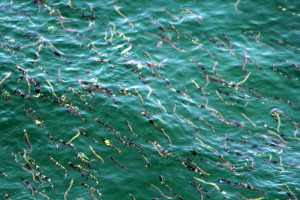
Larger kinds of fishes also feed on these species of schooling fish. Bluefish, Stripers, and even small Bluefin Tuna will feed on these smaller fish. Should you see a boil of larger fish, it is a good idea to keep watchful for other signs of whales.
There will also be places where the surface of the water will be really choppy and then suddenly flat. This can be caused by a number of things. If it was caused by the passing of a vessel it likely will mean nothing. But if it is caused by two currents coming together or by upwelling it can indicate an incredibly productive environment.
As you pass Race Point, unless the sea is very rough, you will find bands of choppier and smoother water. This is where the currents of Cape Cod Bay are meeting with the currents of the Atlantic. As two currents are pushed together, the warmer water generally moves up as the colder water is pushed down. The warmer water rising to the surface creates a chop while the colder water sinking down pulls the surface to flat. Therefore, at Race Point, it is usual to find the smoother band to the Bay side and the choppier band to the ocean side.
Upwelling, like you would find along the edges of Stellwagen Bank, is when the waters are forced to the surface by a physical obstruction. In this case, the Bank itself. Stellwagen is a submerged plateau (a flat-topped mountain) that rises several hundred feet from the sea floor. The steep sides of the mountain force the cold and nutrient rich waters from the sea floor to the surface.
Any place where water is forced from below the surface to the surface level is a productive place. The water brings with it dissolved oxygen (and the deeper the water comes from the more oxygen it holds) and dissolved nutrients (kind of like natural fertilizers). The dissolved oxygen is what marine animals breathe (well, that is essentially it, anyway). The nutrients are absorbed by the phytoplankton (the grass of the sea) and utilized to make food for themselves in very much the same way that plants on land make food utilizing nutrients and sunlight. They, in turn, become the food source for zooplankters, like small copepods, which are then fed upon by larger and larger and larger predators as we work our way up the food chain. But back to the bottom. Places where water brings its nutrients to the surface are places where plants thrive and animals feed on them over the entire span of the food chain. And are therefore places that tend to be productive for whale sightings.
The surface of the water can also tell you things about the movement of large animals, as well. If you have been whalewatching, you may have noticed the circular slicks left behind by a large whale. Sometimes these are caused simply by the whale’s body as it dives. Usually, they are caused by the motion of the whale’s tail as it swims beneath the surface. Fish swim through the water by moving their tails from side to side, but whales propel themselves by moving their tails up and down. A whales’s flukes move the water with such force that the surface chop can by undone by the vertical column of water moved by the stroke of a whale’s tail. When a whale is moving close to the surface, you can follow its progress by tracking the “flukeprints.” The whalers used to know this and so do whalewatch spotters.
The surface of the water can also indicate the presence of large animals in another way. Right Whales tend to spend time moving just below the surface, but at slow enough speeds that their movements do not send flukeprints to the surface. The movement of a large body near the surface, even at slow speeds, changes the texture of the surface water. You can’t really put your finger on what you are seeing. You just know it is different from the water around it. Even in the scientific community, it is referred to as “funny water.”
And, of course, there are the bird balls. A bird ball is a group of birds that are moving around very excitedly, very loudly, and very aggitatedly just above the surface of the water. They are not flying high in the air. Nor are they sitting on the water. They are hovering just above the surface. Most of the seabirds that we are likely to encounter on our whalewatches and most of the whales that are common here feed on the same species of small, schooling fish. So, where there is a birdball, there is likely fish and where there is fish, there might be whales.
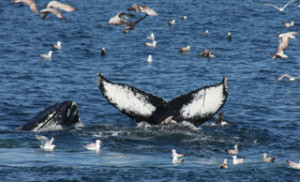
We do also watch for whales in the same ways that whalers watched for whales. Provincetown has a rich whaling history. In fact, at one time, it was the fifth largest whaling port in the country, owing the second largest per capita income of any city in the US to the industry. Yeah, they knew how to find whales. And they taught their children and their grandchildren. Grandchildren that grew up to be fishermen and grandchildren that grew up to be whalewatch captains.
Direct signs of whales are fairly evident. You watch for parts of the whale’s body breaking the surface of the water. I could be the back of the animal, the dorsal fin, the tail (or flukes) of the whale or, if you are very lucky, one of the flippers or even the head. All would appear, in the distance, as dark and irregular shapes that broke through the surface, moved along briefly, and disappeared beneath the surface once more. As you get a bit closer, they take on more distinct colors and shapes.
And, of course, there are the spouts. As mammals, whales breath air, just like we do. Except that whales are expelling the contents of absolutely much larger lungs (though slightly smaller in reference to body size) in the same time frame as we are exhaling. The moisture in the warm air leaving their lungs condenses into visible water droplets that look like a plume of steam that rises from the surface of the water. It is very much like when you go outside on a cold day and can see your breath in front of your face. Ok, your breath is visible for about a foot or two and that of a whale might be visible for 10 or 15 or 20 above the surface of the water.
The signs of whales cited most frequently by the reporting naturalists were birds and spouts. The big kudos by the passengers appeared to go to the diving Northern Gannets. Plunge-diving gannets were highlighted in the reports for at least four of the ten trips that went this week.





